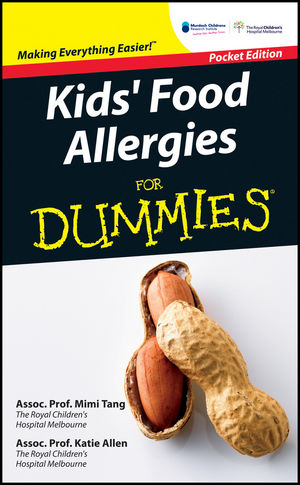Kids’ Food Allergies for Dummies – A must-read for parents of children with food allergies
09/07/2016
In Australia, food allergies are estimated to affect approximately 10% of infants under one year of age and 4-8% of children under five years of age (1). Not only are food allergies common, research demonstrates the incidence of food allergies and hospital admissions for anaphylaxis related to food allergies, is rising at a rapid pace (2).
Managing food allergies is vital for the safety of children. Kids’ Food Allergies for Dummies, written by Associate Professors Mimi Tang and Katie Allen of the Royal Children’s Hospital in Melbourne, is an excellent resource for parents and carers of children with food allergies.
The best defense against a serious allergic reaction is knowledge and this book provides parents and carers everything they need to know, from prevention and diagnosis through to caring for kids at home, school or away on holidays.
The book seeks to educate parents in how to:
– Look after your child in your home and on the go — organise your home and make travel plans that cater for your child’s needs
– Provide a safe environment at school or the childcare centre — set up your school or centre to manage allergies with confidence
– Prepare your child to take responsibility for a food allergy — ensure your child knows about problem foods
– Know when allergic reactions are serious — be prepared to treat and manage anaphylaxis
– Get to grips with the difference between types of food allergy — identify immediate and delayed food allergies
– Understand why allergy rates are on the rise — access the latest research on what causes allergies, and how to avoid them
– Prepare for allergy testing — learn how your child is tested and how you can get involved
– Look into future treatments — get a grasp on new allergy treatments and possible cures
Also included within the book:
– Clear instructions for using adrenaline autoinjectors, otherwise known as EpiPens
– Simple explanations about different types of food allergy
– Information about how to recognise and treat allergic reactions
– Sample emergency action plans
– The latest research on finding a cure for food allergy
– Key lessons to teach children with food allergy
– Suggestions for food replacements
– Websites to access further support
About the authors:
Associate Professor Mimi Tang is a paediatric allergist and immunologist, and Associate Professor Katie Allen is a paediatric gastroenterologist and allergist. Both run patient clinics at The Royal Children’s Hospital, Melbourne and conduct research at the Murdoch Childrens Research Institute and teach at The University of Melbourne.

Do you suspect your child may have a food allergy?
At the Australian Allergy Centre, we have a team of passionate and dedicated healthcare professionals who specialise in the diagnosis and management of food allergies. All medical consultations at the Australian Allergy Centre are medicare rebatable and no referral is necessary. Skin prick testing for food allergens is available. This panel covers milk, egg, a variety of grains, seafood, meats, fruits, vegetables and peanut. An extended nut panel is also available. This panel includes peanut, walnut, hazelnut, pecan, pistachio, almond, macadamia, brazil, pine and cashew nuts.
For more information or to book an appointment, contact us on 1300 MY ALLERGY.
NB: The self-diagnosis of food allergies is dangerous. Self-diagnosis can lead to unnecessary dietary restrictions and subsequent, nutrient deficiencies. Without seeking professional advice, individuals also place themselves at risk for harm associated with the missed diagnosis of other potentially life-threatening medication conditions.
Reference List:
(1) Australasian Society of Clinical Immunology and Allergy [ASCIA]. 2015. Food allergy. Information for patients, consumers and carers. Accessed July 31, http://www.allergy.org.au/images/pcc/ASCIA_PCC_Food_Allergy_2015.pdf
(2) Mullins, R., Dear, K. and Tang, M. 2015. Time trends in Australian hospital anaphylaxis admissions in 1998-1999 to 2011-2012.Journal of Allergy and Clinical Immunology. Published online: July 13, 2015. DOI: http://dx.doi.org/10.1016/j.jaci.2015.05.009